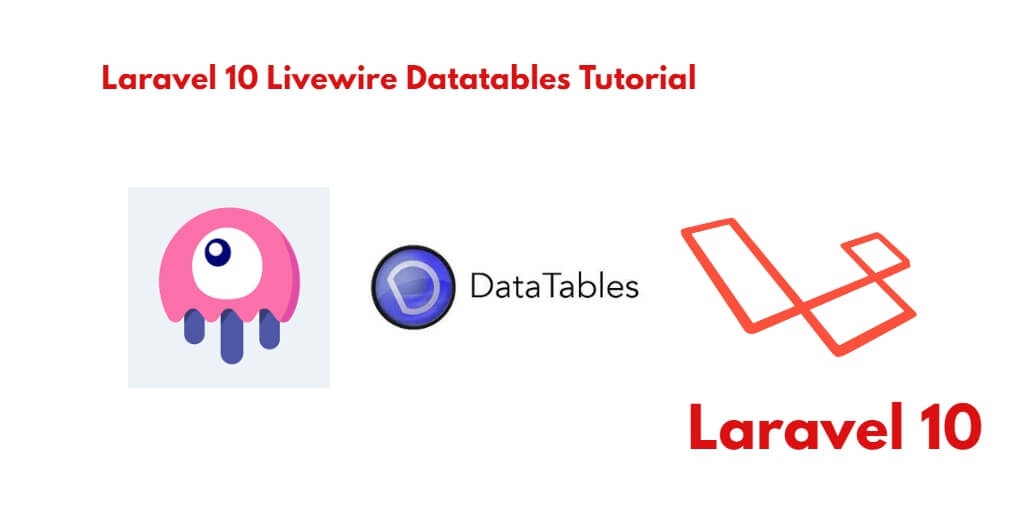If you want to render data in Laravel web applications using Livewire DataTable then this tutorial is for you. So, In this tutorial, you will learn how to install and use livewire dataTable in Laravel 10 app.
Laravel 10 Livewire Datatables Example Tutorial
Steps to install and use Livewire DataTable in your Laravel 10 app.
- Step 1 – Setup New Laravel 10 Project
- Step 2 – Configure Database to Laravel Project
- Step 3 – Install Livewire & DataTable Livewire
- Step 4 – Create Livewire DataTable Component
- Step 5 – Define Routes
- Step 6 – Update UserDataTable Component File
- Step 7 – Import Component in Welcome Blade File
- Step 8 – Start Development Server
Step 1 – Setup New Laravel 10 Project
Firstly, Open your terminal or cmd(command prompt).
Then you need to download or install Laravel 10 new setup in your server:
composer create-project --prefer-dist laravel/laravel Laravel8CRUD
Step 2 – Configure Database to Laravel Project
Once you have installed laravel project in your server. Then you need to configure your database with your apps.
So, visit your app root directory and find .env file. Then configure database details as follows:
DB_CONNECTION=mysql DB_HOST=127.0.0.1 DB_PORT=3306 DB_DATABASE=database-name DB_USERNAME=database-user-name DB_PASSWORD=database-password
Step 3 – Install Livewire & DataTable Livewire
In this step, execute the following command on terminal to install livewire and dataTables livewire package in Laravel 10 app:
composer require livewire/livewire composer require mediconesystems/livewire-datatables
Then, execute the “npm install && npm run dev” command to build your assets:
npm install
To run npm:
npm run dev
Then, Execute the following command on the terminal to create tables into the database:
php artisan migrate
Step 4 – Create Livewire DataTable Component
In this step, create users dataTable livewire components by executing the following command on terminal:
php artisan make:livewire user-datatables
This command will create two files, which is located on following path:
app/Http/Livewire/UserDatatables.php resources/views/livewire/user-datatables.blade.php
Step 5 – Define Routes
In this step, create routes for laravel livewire dataTable app. So, open web.php file from the routes directory of laravel livewire data tables app. And update the following routes into the web.php file:
Route::get('user-datatables', function () {
return view('welcome');
});
Step 6 – Update UserDataTable Component File
Now, update the UserDatatables.php component file with the following code, which is placed on app/Http/Livewire directory:
<?php
namespace App\Http\Livewire;
use Livewire\Component;
use App\Models\User;
use Illuminate\Support\Str;
use Mediconesystems\LivewireDatatables\Column;
use Mediconesystems\LivewireDatatables\NumberColumn;
use Mediconesystems\LivewireDatatables\DateColumn;
use Mediconesystems\LivewireDatatables\Http\Livewire\LivewireDatatable;
class UserDatatables extends LivewireDatatable
{
public $model = User::class;
/**
* Write code on Method
*
* @return response()
*/
public function columns()
{
return [
NumberColumn::name('id')
->label('ID')
->sortBy('id'),
Column::name('name')
->label('Name'),
Column::name('email'),
DateColumn::name('created_at')
->label('Creation Date')
];
}
}
Step 7 – Import Component in Welcome Blade File
In this step, open welcome.blade.php file and update the following code into it, which is placed on resources/views/ directory:
<!DOCTYPE html>
<html>
<head>
<title>Laravel 10 Livewire DataTable Example - Tutsmake.com</title>
@livewireStyles
<link rel="stylesheet" href="https://cdnjs.cloudflare.com/ajax/libs/tailwindcss/1.9.2/tailwind.min.css" integrity="sha512-l7qZAq1JcXdHei6h2z8h8sMe3NbMrmowhOl+QkP3UhifPpCW2MC4M0i26Y8wYpbz1xD9t61MLT9L1N773dzlOA==" crossorigin="anonymous" />
</head>
<body>
<div class="container">
<div class="card">
<div class="card-header">
Laravel Livewire Example - Tutsmake.com
</div>
<div class="card-body">
<livewire:user-datatables
searchable="name, email"
exportable
/>
</div>
</div>
</div>
</body>
@livewireScripts
</html>
Now, execute the following command on the terminal to create dummy records in database:
php artisan tinker User::factory()->count(100)->create()
Step 8 – Start Development Server
Last step, open command prompt and run the following command to start developement server:
php artisan serve
Then open your browser and hit the following url on it:
http://127.0.0.1:8000/user-datatables

Hi, the livewire datatables package is currently not compatible with laravel 10.
Reason:
– Root composer.json requires mediconesystems/livewire-datatables 0.10.1 -> satisfiable by mediconesystems/livewire-datatables[v0.10.1].
– mediconesystems/livewire-datatables v0.10.1 requires reedware/laravel-relation-joins ^2.4|^3.0|dev-l10-compatibility -> found reedware/laravel-relation-joins[v2.4.0, v2.4.1, v2.4.2, v3.0.0] but it conflicts with your root composer.json require (^4.0).